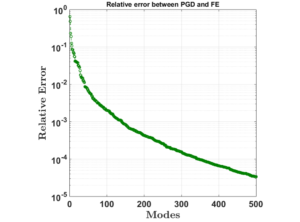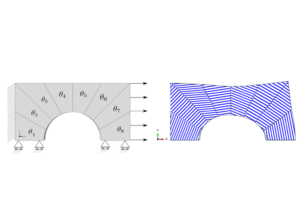Composite materials are gaining popularity as an alternative to classical materials in many different applications. Moreover, their design is ever more flexible due to the potential of additive manufacturing. Thus, one can produce a tailored composite laminate with the optimal values of some design parameters providing the desired mechanical performance. In this context, having a parametric numerical model for the mechanical response of the composite laminate is essential to compute the optimal parameters. In the present work, the design parameters under consideration are the angles describing the orientation of the reinforcement fibres in different patches of composite laminates.
Our CompMech member Karim El-Ghamrawy is working on finding the best fibre orientation in composite laminates that minimizes the failure of the material using the Tsai-Wu failure criterion. This naturally leads to an optimization problem that has to be solved a large number of times, corresponding to different choices of the design parameters. Thus, the computational complexity of this procedure blows up with the number of design parameters, resulting in the so-called curse of the dimensionality. The use of a Model Order Reduction (MOR) technique is advocated to alleviate this computational burden. We obtain the computational vademecum, which contains all possible solutions of the problem and acts as a virtual chart, using the Proper Generalized Decomposition (PGD). The computational vademecum is typically computed in an offline phase that may take important computational resources. Once the offline phase is done, the solution depending on the parameters explicitly is available; and exploring the parametric space (e.g. for an optimization problem) is a simple post-process, which is extremely fast (see Video1), and it can be conducted online in real time.
The results obtained show the huge potentiality of the methodology, where the solutions obtained show great agreement with FE having a relative error less than 0.01% as shown in Fig. 1. In Fig. 2, we show the ability to predict the optimal fibre orientation for a plate with a circular hole in the middle under tensile load. The results are obtained using the in-house built code that is developed, maintained, and distributed by LaCaN at the Polytechnic University of Catalonia (UPC) [1,2] and the package of routines is publicly available.
This work is supported by the European Education, Audiovisual, and Culture Executive Agency (EACEA) under the Erasmus Mundus Joint Doctorate “Simulation in Engineering and Entrepreneurship Development (SEED)”, FPA-2013-0043. The work is under the supervision of Prof. Ferdinando Auricchio, Prof. Pedro Díez, and Prof. Sergio Zlotnik.
References
[1] P. Díez, S. Zlotnik, A. García-González, and A. Huerta, “Encapsulated PGDAlgebraic Toolbox Operating with High-Dimensional Data,”Archives of Computational Methods in Engineering, 2019
[2] P. Díez, S. Zlotnik, A. García-González, and A. Huerta, “Algebraic PGD fortensor separation and compression: An algorithmic approach,”Comptes Rendus- Mecanique, vol. 346, no. 7, pp. 501–514, 2018
June 19th, 2020



